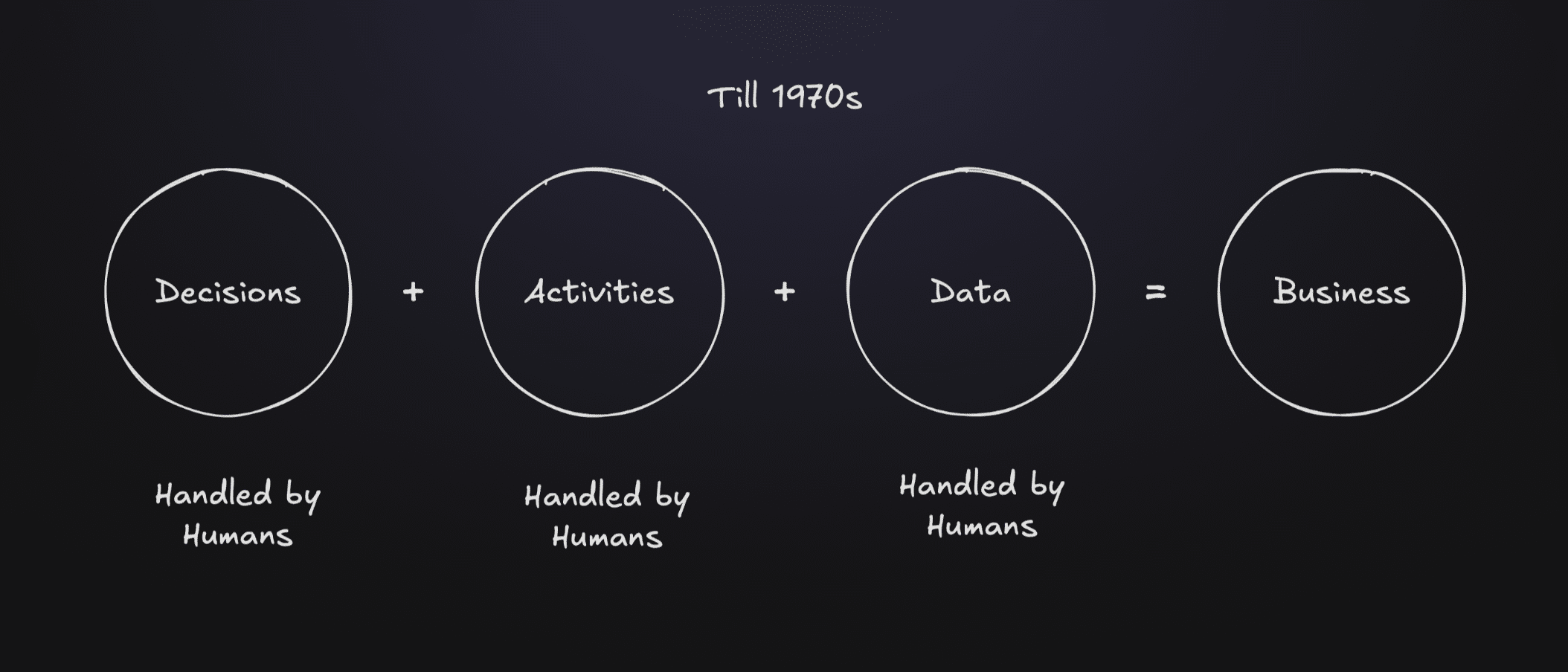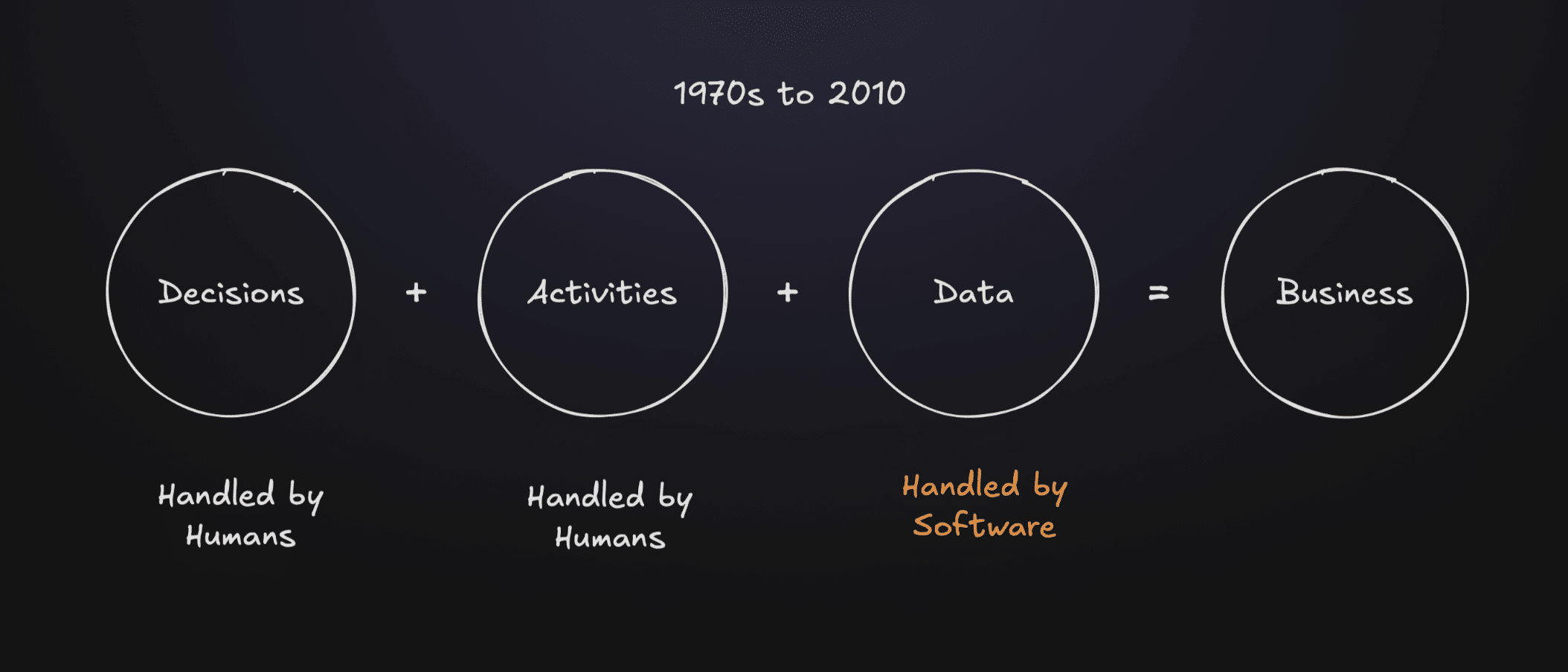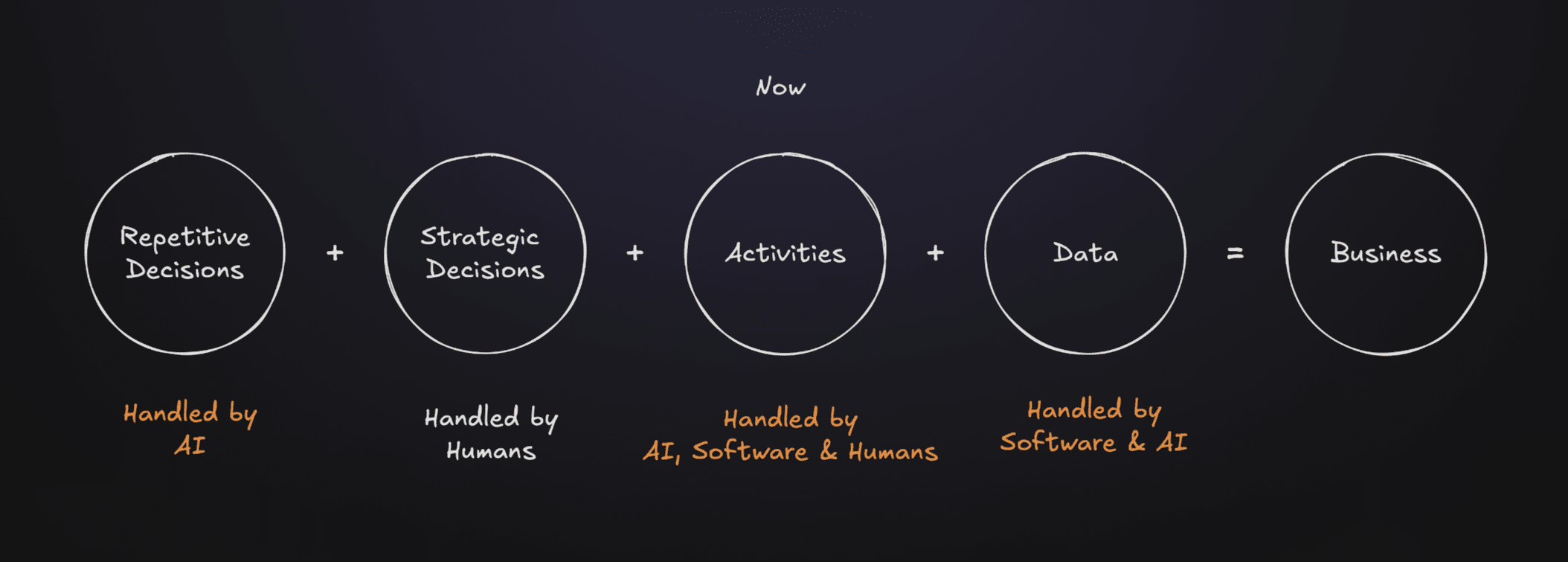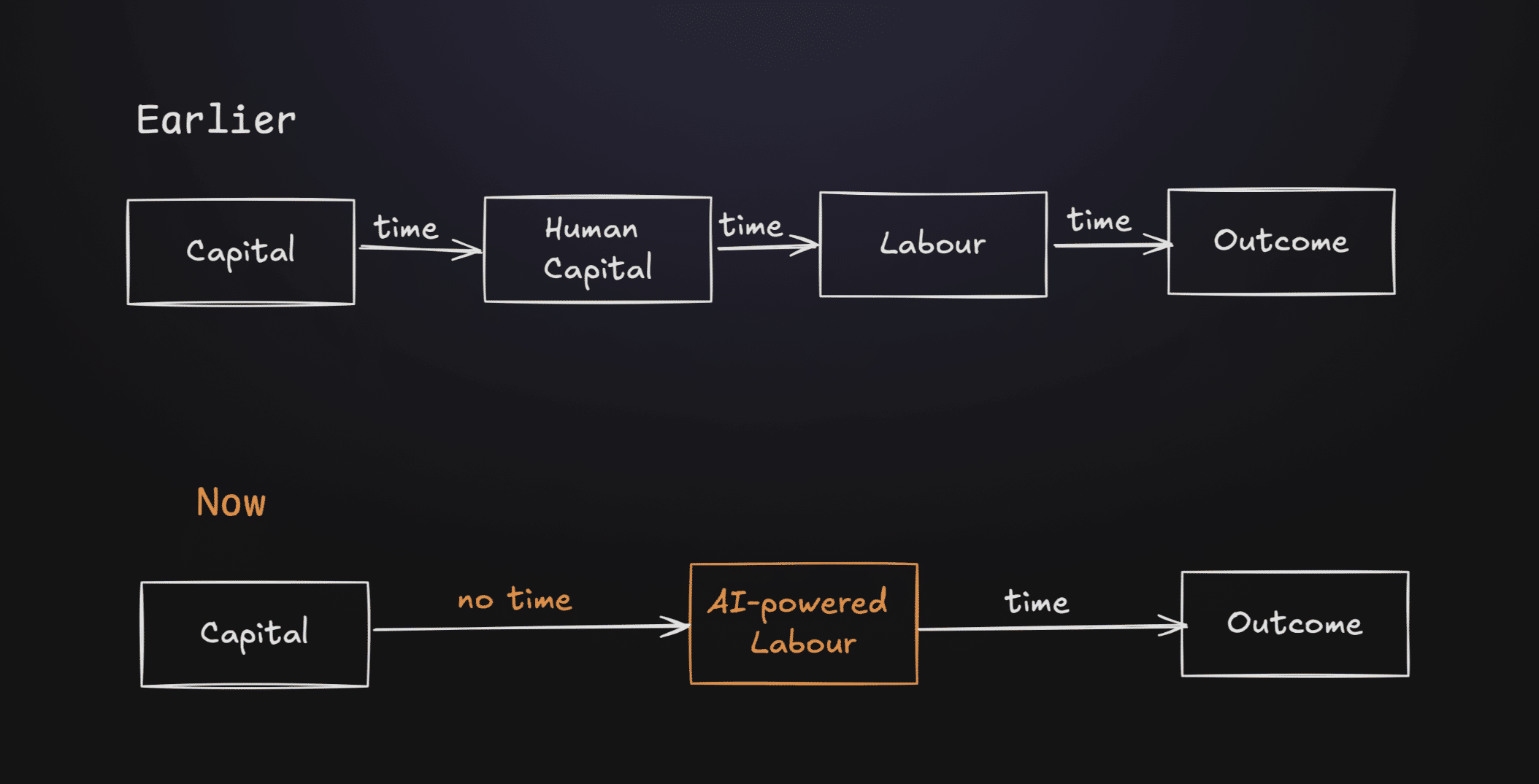The Evolution of Business: From Manual to SuperIntelligence
Historically, business has been defined by its core activities and purpose. Investopedia succinctly describes it as “an organization or enterprising entity engaged in commercial, industrial, or professional activities.” In essence, business is about activities. But activities can be done for other purposes as well – for leisure, or charity. Then how is business different? Business has a purpose – a common goal that needs to be achieved over a period of time and the progress towards that goal needs to be tracked. That’s where data comes in.

For most of the 20th century, businesses relied heavily on human capital to fulfill three primary components: activities, data management, and decision-making. The 1970s saw accountants meticulously maintaining books, while customer relationships were nurtured through physical rolodexes. This era, though seemingly simplistic by today’s standards, laid the groundwork for what was to come.
The advent of computers and software in the late 20th century ushered in a period of digital transformation. Software became the new “System of Record,” enhancing data persistence and accessibility. The shift to cloud computing further amplified these benefits, making data storage and sharing more efficient than ever before.

Post-2015, we witnessed the rise of machine learning in real-world applications. This period marked the birth of data-driven decision-making, with recommendation systems, computer vision, and natural language processing taking center stage. The term “Business Intelligence” gained prominence, signifying a new era where data began to influence strategic priorities.

Fast forward to the present time, AI Agents have now become a reality. These agents have the agency to make decisions and perform certain activities. Does this mean humans are completely unnecessary when running a business? Not at all. Let’s understand why. A large portion of human time goes into repetitive activities that require less complex decision-making. AI will handle these tasks for humans, which will allow humans to be more strategic and more productive than ever.

We are entering the era of Business SuperIntelligence, where humans, AI, software, and data will all play equally important roles. Their roles will evolve over time, and the future workforce will be hybrid in nature comprising of humans and AI Agents. Let’s go deeper into the synergies that will emerge out of the interactions of these four components.
Synergies between Four Pillars of Business SuperIntelligence
- Data: So far businesses have relied mostly on structured data. Not because, structured data was easily available, but mainly because it was easier to record, maintain, and process this type of data. With AI, the nature of data itself will shift from structured to unstructured and from single modality (text) to multimodal (text, videos, audio, etc.). As a result, the data sources, the data capturing & processing pipeline, and the decision-making processes will also need to evolve.
- Software: It might be difficult to imagine how software evolves because of AI. Building software will be easy, agreed – but the end output – will that be different from the current software we use? The software which we have built so far was never built for intelligence. It was always made for deterministic inputs and outputs. We never tried to handle the known unknowns with Software because that was simply not feasible. While the old age software was heavily guardrailed, the new age software will be more flexible and ambitious. The early signs of this can be seen in consumer support agents. The old stack which involved hundreds of manually designed rules is getting replaced by the new stack which simply consumes a knowledge base and handles complex scenarios effortlessly. The fewer rules (code) you write, the more generic your agent is. Tactically speaking, the new age software will be built for generic capabilities and it will also be interactive based on real-time context.
- AI: We are all aware of how LLMs are becoming better at reasoning, multimodality, and handling longer contexts. But we are not discussing technical evolution here. Our goal is to understand that what additional roles will AI get better at. Till now, AI has been helping us in specific parts of the value chain like extracting insights from data, generating content, transcribing meetings, etc. But going forward, AI will be able to connect the dots and will start covering a larger portion of the value chain. Let’s take a specific case, say sales. AI SDRs are now able to automatically mine leads, conduct deep research, and generate personalized outreaches. But upon close observation, you’ll notice that this is still one end of the sales value chain. In futuristic systems, AI SDRs will be intimately coupled with your software stack (CRM, Support App, etc.). This will allow them to handle objections, book demos, conduct demos, and close deals. But the evolution doesn’t stop here. With enough usage, AI SDRs will be able to customize the GTM strategy in real-time for every lead. They will predict the right set of actions and assign these actions to either themselves or human AEs. So, the role of AI will gradually expand from execution to strategy.
- Humans: We just saw how AI will be playing a role not just in the execution of mundane tasks but also in strategic decisions. Does that mean that the role of humans will become limited in the future? No! As AI takes over some of the backend actions and decisions, humans will be able to focus on higher-touch, higher-value, and more strategic outcomes. We have already seen some hard skills like calculation, memorization, etc. becoming less relevant due to the advent of software. AI will make some other skills obsolete. For example, due to AI, we no longer need to have a good command of grammar and vocabulary to write a good article. AI takes care of these aspects, we only need to have good ideas and a good taste for distinguishing extraordinary work from ordinary content. Just as great directors are not necessarily great actors, humans will also need not be good at execution but should be good at envisioning things and providing feedback.
Spiky is revolutionizing AI-powered meeting analytics, helping businesses enhance productivity and optimize decision-making with real-time insights. Unlike traditional business intelligence tools, Spiky leverages advanced AI to analyze meeting dynamics, track speaker engagement, and provide data-driven recommendations that improve collaboration and efficiency. Automating meeting analysis frees professionals from manual assessments, allowing them to focus on strategic growth and high-value interactions. As AI-driven business intelligence becomes essential for modern organizations, Spiky stands out as a powerful solution that boosts team performance, streamlines workflows and drives smarter decision-making.
Downstream Implications of SuperIntelligence
Outcome-based Monetization
Superintelligence is not about intelligent insights or actions, it has to be tethered to outcomes. If you’re not able to deliver outcomes, then probably your insights and actions are not smart enough. If you’ve customers who are paying you for outcomes, then most probably your monetization is directly tied to their growth. This direct linkage was missing in the SaaS products because subscription-based monetization is always constrained by time. Let’s understand this with an example, if a B2B customer is super successful it will hire more people in sales, which will increase the no of seats in the CRM, but this growth will have some associated inertia because hiring and onboarding is a slow process. Whereas, if the same B2B customer is using AI SDR, the business growth is no longer constrained by human capital, and the time to convert capital into labor is reduced by orders of magnitude. This sets the ground for exponential growth.

Quality over Quantity
When Business SuperIntelligence starts owning a larger share of the value chain, then it can charge higher ACVs than it SaaS counterparts. AI-powered labour will lead to exponential growth of existing customers which implies higher Expansion ARR. If the top 10% of your users drive all the monetization, then it’s the quality of users (and their ACV) that matters, not just the scale of users. Business Applications may start looking more like some Consumer Applications such as Free-to-play games which often have “whale monetization” mechanics where the top users can spend thousands of dollars if they want.
Intelligence based Costs
Today, we think of LLM costs in terms of no. of tokens consumed. However, what we often ignore is the fact that intelligence is already baked into the pricing. That’s why GPT 4 is priced higher than GPT 3.5. The counterintuitive insight here is that there are cases where GPT 4 will be cheaper than GPT 3.5 because it is an intelligent model that can probably solve a given task with less no. of tokens. Recently, OpenAI released its new family of models called o1. It seems to “think” before responding, highlighting that not all tokens are created equal. We’re moving towards a paradigm shift—away from traditional token-based billing and towards intelligence consumed.
The Road Ahead
As we embrace Business Superintelligence, companies must reimagine operations, valuing both human and AI strengths. Successful businesses will thrive by combining human expertise with AI, setting new standards for productivity and innovation.
Welcome to the age of Business Superintelligence—where the impossible becomes routine, and the future arrives faster than we ever imagined.








